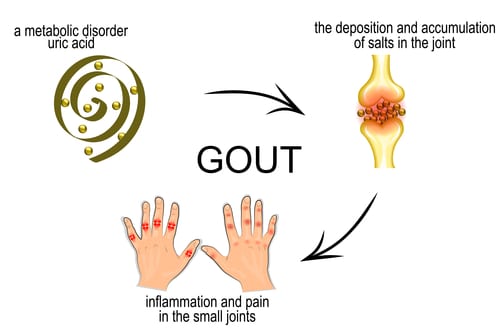Fast Facts About Gout
Historically, gout was referred as “the king of diseases and the disease of kings” or “rich man’s disease” and its’ first documentation goes back all the way to 2600 BC Egypt. Why? It’s obvious that royalty and the rich could afford meats, alcohol and liked to fatten themselves up with other rich foods, as for the lower class they were stuck with a carbohydrate diet, whatever fruits and vegetables they raised on their land, rarely eating any meat but living a healthier life! Several hundred years ago gout was also thought to be caused by drops of viscous humors that seeped from blood into the joints. The word Gout is derived from Latin word gutta meaning “a drop of liquid” and has the unique distinction of being one of the most frequently recorded medical illnesses throughout history.
What Causes Gout Exactly?
What causes gout is excess uric acid in the body and is one of the most painful form of arthritis. It’s a complex disorder that is more prevalent among men, and afflicts women more commonly after menopause. Besides men have higher uric acid levels in their blood than women, that’s why nearly 6% of men have it and 2% of women in the US. That’s about 8 million Americans that have gout! Gout is a kind of arthritis caused by a buildup of uric acid crystals in the joints.
Uric acid has no useful function in the human body; it is simply a breakdown product of purines, a group of chemicals present in all body tissues and many foods. Uric acid is a breakdown product of purines that are part of many foods we eat mostly found in meats, seafood etc… An abnormality in handling uric acid and crystallization of these compounds in joints can cause attacks of painful arthritis, kidney stones, and blockage of the kidney filtering tubules with uric acid crystals and may lead to eventual kidney failure.
Most of the time uric acid dissolves and goes into the urine via the kidneys. However, if the body is producing too much uric acid, or if the kidneys are not excreting enough uric acid, it builds up. The accumulation may result in sharp urate crystals which look like needles.(1) They accumulate in the joints or surrounding tissue and may cause pain, inflammation and swelling.
It’s usually characterized by recurrent attacks of acute inflammatory arthritis—a red, tender, hot, swollen joint (God knows I’ve had many) and the most commonly affected area is the big toe 50% of the time and is called podagra. Other joints that can be affected include the ankles, knees, wrists, fingers, heels and elbows and it is wise to always rest the joint that hurts as much as possible. In some people, the acute pain is so intense that even a bed sheet on the toe causes severe pain.
I’ve personally have had sleepless nights of tossing and turning, trying to numb the pain with a bag of ice. Usually, the gout attacks occur in the middle of the night, supposedly the coolness and temperature drop facilitates the crystallization of the uric acid in the joint.
Digging deeper, high levels of uric acid in the blood called Hyperuricemia is the underlying cause of gout. Surprisingly, hyperuricemia is commonly found in many people who never develop gout. Scientists are not completely sure what causes hyperuricemia. There is definitely a genetic factor because a person who has close relatives with hyperuricemia is more likely to develop it himself.
To confirm a diagnosis of gout, your doctor may draw a sample of fluid from an inflamed joint to look for crystals associated with gout or do a blood test to measure the amount of uric acid in the blood.
Who’s At Risk?
Finally, you are more likely to have gout if you are a male, obese, is in your family genes, drink excessive alcohol, eat foods high in purines, regular aspirin, niacin or diuretics use, hypertension, lead poisoning, surgery etc… Complications may also arise from gout like recurrent gout, advanced gout in which urate crystals may form under the skin in nodules otherwise know as tophi, kidney stones may cause urate crystals to accumulate in the urinary tract, gout may also spread to other joints and obviously cause damage to the joints.
Myths About Gout
Despite gout being an increasingly common disease, there are still a lot of myths about it that people believe. Let’s take a look at what they are and debunk each one.
Myth 1: Only the rich and obese get gout
At one time this was true, but these days, hardly. The regular person now has access to all sorts of food and with processed food becoming more common, it’s not hard to be at risk for developing gout. Your yearly income has nothing to do with gout but your genes certainly does. If one of your parents had gout, you’re likely to develop it later on if you’re not careful.
Myth 2: Gout only attacks the big toe
It is very common for the first gout attack to happen in the big toe. But uric acid doesn’t just accumulate crystal deposits here. It can affect other joints too like your elbows, hands, knees, and ankles.
Myth 3: Only men can have gout
Women too can have gout but they are at lesser risk than men. This is due to the fact that women have estrogen which helps remove uric acid in the body. Once they hit menopause, they are more likely to develop gout.
Myth 4: If you keep a healthy diet and avoid gout triggers, you can avoid gout attacks.
While maintaining a healthy diet and avoiding high purine foods is important for managing your gout symptoms, this alone will not make your condition go away. Unfortunately, gout is an irreversible condition; once you have it, you have it forever. The good news is that there are now numerous medications you can take to manage your condition. There’s medicines specifically for lowering uric acid and then there’s also some for getting rid of the pain and swelling. If you have conditions like kidney disease along with your gout, there’s medicine for that too.
Myth 5: Gout is a self-inflicted condition
This is often one of the biggest myths that gout patients has had to debunk for people they know. It’s very common to joke about gout because it was once known as a rich man’s disease. Sure, lifestyle can be a contributing factor to developing gout, but as we mentioned earlier, it is also genetic. So it doesn’t matter how good you are with dieting and exercising, if your family history has it, you’re more likely to have it too.
Myth 6: Gout is an old man’s disease
Men are more likely to get gout earlier in life. This is due to a combination of factors: genes and our modern lifestyle. If you live a high stress life and eat an unhealthy diet, you’re more likely to inherit gout from one of your parents.
What has your experience been like with gout? When were you diagnosed with it and how did you deal with it? Share your thoughts in the comments below.
Credits
1. www.medicalnewstoday.com

